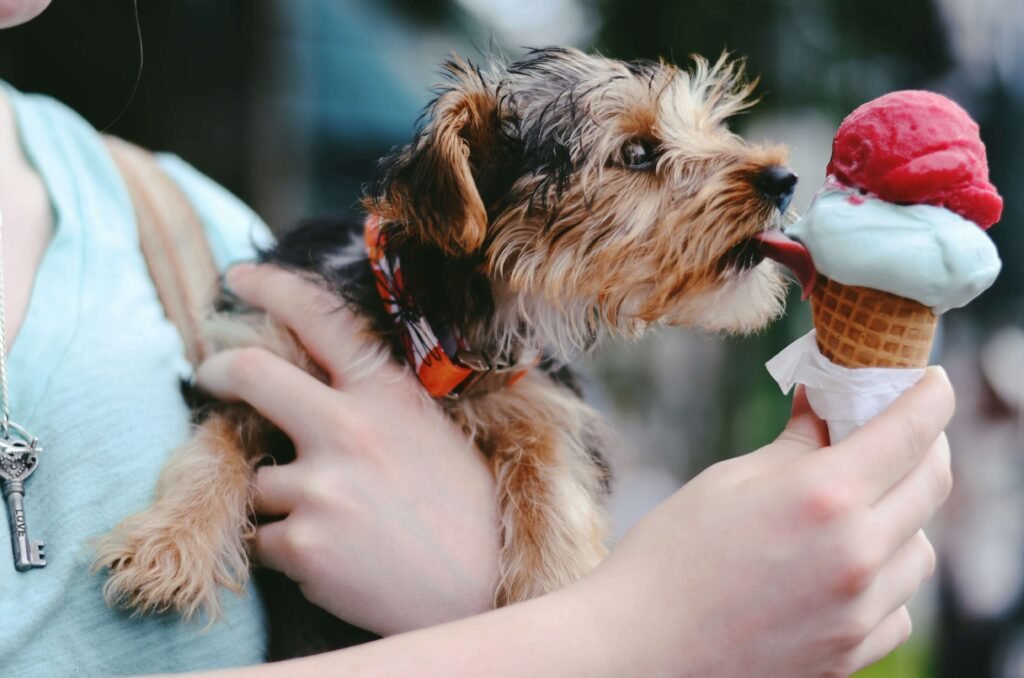Is It Safe for Your Dog to Eat Ice Cream? A Guide for Pet Owners
There’s nothing quite like indulging in a cold, creamy scoop of ice cream on a hot summer day. But what about your furry best friend? If you’ve ever caught your dog eyeing your dessert with longing, you might wonder if it’s safe for them to join in the fun. While the idea of sharing ice cream with your pup may seem harmless, there are important considerations to keep in mind. From lactose intolerance to potential allergens, understanding the risks and benefits is key to ensuring your dog’s health and happiness.
In this blog post, we’ll explore everything you need to know about dogs eating ice cream, including safe alternatives and tips for treating your pet responsibly. Let’s dive into the sweet world of canine desserts while keeping your dog’s well-being at the forefront.
Why You Should Be Cautious About Giving Your Dog Ice Cream
While it might be tempting to share your favorite frozen treat with your dog, there are several reasons why ice cream isn’t always the best choice for them. Understanding these concerns can help you make informed decisions about what’s safe for your pet.
Lactose Intolerance : Most dogs lack sufficient lactase, the enzyme needed to digest lactose, which can lead to digestive upset.
High Sugar Content : Excessive sugar can contribute to obesity, diabetes, and dental issues in dogs.
Artificial Additives : Many ice creams contain artificial flavors, colors, or preservatives that may not be safe for canine consumption.
Chocolate and Xylitol : These common ice cream ingredients are toxic to dogs and should be avoided at all costs.
Dairy Sensitivities : Even if your dog isn’t lactose intolerant, dairy can still cause bloating, gas, or diarrhea.
By being aware of these potential risks, you can protect your dog from unnecessary discomfort or health issues while still finding ways to spoil them safely.
Signs Your Dog May Have Eaten Something They Shouldn’t
If your dog sneaks a bite of ice cream or any other human food, it’s important to recognize the signs of an adverse reaction. Early detection can prevent more serious complications down the line.
Vomiting : This is one of the most immediate signs that your dog’s stomach is upset.
Diarrhea : Loose stools often indicate difficulty digesting certain ingredients.
Lethargy : A sudden lack of energy could signal that your dog is feeling unwell.
Excessive Drooling : This may indicate nausea or irritation in their mouth or throat.
Allergic Reactions : Symptoms like swelling, itching, or difficulty breathing require immediate veterinary attention.
If you notice any of these signs after your dog eats ice cream, consult your veterinarian promptly to ensure their safety.
Check this guide 👉Homemade Dog Ice Cream Recipe: Best 7 Expert Tips!
Check this guide 👉Can Dogs Eat Whipped Cream? Best 7 Health Tips!
Check this guide 👉Dog Ate Chocolate Chip Cookie: Best 7 Expert Tips!

Ice Cream Ingredient | Safety for Dogs |
|---|---|
Lactose (Milk/Dairy) | May cause digestive upset |
Sugar | Harmful in large amounts |
Chocolate | Toxic to dogs |
Xylitol | Highly toxic |
Natural Fruit (e.g., Banana) | Safe in moderation |
Safe Alternatives to Ice Cream for Your Dog
If you want to treat your dog to something cool and refreshing without the risks associated with traditional ice cream, there are plenty of dog-friendly alternatives to consider. Here are some ideas to satisfy your pup’s cravings:
Frozen Yogurt : Opt for plain, unsweetened yogurt and freeze it in small portions for a healthier treat.
Peanut Butter Popsicles : Mix peanut butter (xylitol-free) with water or broth, pour into molds, and freeze.
Fruit Sorbet : Blend and freeze dog-safe fruits like blueberries, strawberries, or bananas for a natural treat.
Pumpkin Puree Cubes : Freeze pumpkin puree in ice cube trays for a nutritious and hydrating snack.
Homemade Frozen Treats : Combine cooked chicken broth, mashed sweet potato, and a sprinkle of turmeric for a savory option.
These alternatives allow you to indulge your dog’s sweet tooth while keeping their health in check.
Tips for Introducing New Foods to Your Dog
When introducing new treats or foods to your dog, it’s essential to do so gradually and with caution. These tips will help you ensure a smooth transition and avoid any negative reactions.
Start Small : Offer tiny portions of the new food to monitor how your dog reacts before giving larger amounts.
Check Ingredients : Always read labels carefully to avoid harmful additives or allergens.
Consult Your Vet : If you’re unsure about a particular food, ask your veterinarian for advice tailored to your dog’s needs.
Observe Behavior : Pay close attention to changes in your dog’s behavior or digestion after trying something new.
Avoid Overfeeding : Treats should make up no more than 10% of your dog’s daily caloric intake to maintain a balanced diet.
By following these guidelines, you can safely introduce new foods and treats without compromising your dog’s health.
Common Ingredients in Ice Cream That Are Harmful to Dogs
While ice cream might seem like a harmless treat, many of its common ingredients can pose serious risks to your dog’s health. Being aware of these harmful components can help you make safer choices for your pet.
Chocolate : Contains theobromine and caffeine, both of which are toxic to dogs and can lead to severe health issues.
Xylitol : A sugar substitute found in some low-calorie ice creams, xylitol is highly toxic and can cause rapid insulin release and liver failure.
High Sugar Content : Excessive sugar can lead to obesity, diabetes, and dental problems in dogs over time.
Artificial Sweeteners : Other artificial sweeteners besides xylitol may still upset your dog’s stomach or cause allergic reactions.
Dairy Fat : High-fat content in ice cream can trigger pancreatitis, a painful and potentially life-threatening condition.
By avoiding ice creams with these harmful ingredients, you can protect your dog from unnecessary health risks while still finding ways to spoil them safely.
Fun Ways to Make Dog-Friendly Frozen Treats at Home
Creating homemade frozen treats for your dog is not only fun but also a great way to ensure they’re eating something healthy and safe. These ideas will inspire you to get creative in the kitchen.
Frozen Peanut Butter Bites : Mix peanut butter (xylitol-free) with mashed banana, roll into small balls, and freeze for a tasty snack.
Yogurt and Berry Pops : Blend plain yogurt with blueberries or strawberries, pour into molds, and freeze for a refreshing treat.
Chicken Broth Cubes : Pour unsalted chicken broth into ice cube trays and freeze for a savory option your dog will love.
Pumpkin Delight : Combine canned pumpkin puree with a little water, pour into molds, and freeze for a nutritious dessert.
Fruit and Veggie Medley : Freeze slices of dog-safe fruits like apples or veggies like carrots for a crunchy, hydrating snack.
These homemade treats are not only healthier than ice cream but also allow you to tailor the flavors to your dog’s preferences.
Signs Your Dog Loves Frozen Treats (and How to Tell)
If you’ve introduced frozen treats to your dog, you might be wondering how to tell if they truly enjoy them. Dogs often show their excitement in subtle but unmistakable ways.
Excited Wagging : A wagging tail upon seeing or hearing the treat container is a clear sign of anticipation.
Eager Licking : If your dog licks the bowl or their lips repeatedly, it indicates they’re thoroughly enjoying the treat.
Playful Behavior : Some dogs become playful or energetic after tasting something they love, showing their happiness through movement.
Focus and Attention : A dog that stays focused on the treat or begs for more is clearly a fan of what you’ve offered.
Relaxed Demeanor : After finishing the treat, a content and relaxed demeanor suggests they found it satisfying.
By observing these behaviors, you can gauge your dog’s preferences and continue to provide them with treats they genuinely enjoy.
Frequently Asked Questions About Dogs Eating Ice Cream
Can dogs eat vanilla ice cream?
Plain vanilla ice cream without added sugars or artificial ingredients is less risky, but it can still cause digestive upset due to lactose.
What happens if my dog eats chocolate ice cream?
Chocolate contains theobromine, which is toxic to dogs. Seek veterinary care immediately if your dog consumes chocolate ice cream.
Is lactose-free ice cream safe for dogs?
Lactose-free options are safer but still high in sugar. Offer in moderation and consider dog-friendly alternatives instead.
How much ice cream is too much for a dog?
Even small amounts can upset your dog’s stomach. Stick to dog-safe treats and avoid feeding ice cream regularly.
Can puppies eat ice cream?
Puppies have sensitive digestive systems, making ice cream even riskier for them. Avoid feeding it altogether.
Treat Your Dog Responsibly: A Sweet Ending
While sharing a moment of indulgence with your dog can be heartwarming, it’s crucial to prioritize their health and safety above all else. Traditional ice cream may not be the best choice for your furry friend, but there are countless creative and nutritious alternatives to bring joy to their taste buds. By understanding the risks and exploring safe options, you can create special memories with your dog without compromising their well-being. Remember, a happy and healthy pup is the ultimate reward—and every wag of their tail is worth it.
Why Is My Cats Second Eyelid Showing? Understanding the Nictitating Membrane Your cat blinks slowly… then you notice it — a …
How Do I Know If My Cat Died Peacefully? Best 7 Expert Tips! Discover the quiet signs of a peaceful feline passing and find comfort in their final moments.
How Do I Know If My Cat Died Peacefully? A Gentle Guide for Heartbroken Owners Losing a cat is not just …
Why Do Abyssinian Cat Colors Matter? Best 7 Expert Tips! Discover the genetics, rare hues, and care secrets behind Abyssinian coat colors for a healthier, happier cat.



